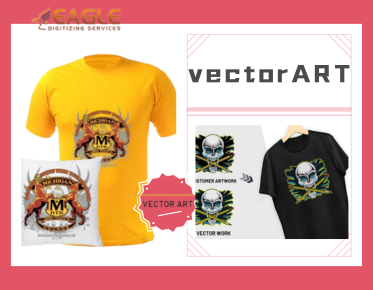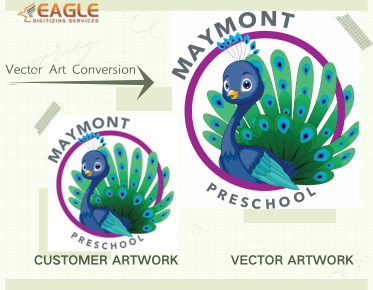What is DTG Printing? Exploring This Trendy Technique?/Eagle Digitizing
Direct-to-Garment (DTG) printing is a cutting-edge technique that involves applying ink directly onto textiles using inkjet technology. Unlike traditional screen printing, which requires stencils and multiple setup steps, DTG printing offers a streamlined approach by directly printing designs onto garments. This method is celebrated for its ability to produce detailed, full-color images with exceptional clarity and precision. For the premier online vector conversion, feel free to connect with us.
How DTG Printing Fits into the World of Textile Printing
In the expansive realm of textile printing, DTG stands out for its digital approach. It complements other methods like screen printing and heat transfer by offering a solution for high-resolution, custom designs. DTG printing is particularly valuable in the niche of on-demand printing and small batch runs, where traditional methods may not be as cost-effective or practical.
How DTG Printing Works
The DTG Printing Process Explained
The DTG printing process begins with a digital design loaded into a specialized printer. The garment is pre-treated with a solution to enhance ink adhesion. The printer then sprays tiny droplets of ink onto the fabric, layer by layer, to build up the design. After printing, the garment is heat-pressed to cure the ink, ensuring it adheres firmly and remains vibrant.
Key Components of a DTG Printer
A DTG printer consists of several crucial components: a print head, which applies the ink; an ink delivery system, which supplies and manages the ink; and a platen, which holds the garment in place during printing. The printer also includes a control panel for managing print settings and a curing unit for setting the ink.
Understanding the Inkjet Technology Behind DTG
DTG printers utilize inkjet technology, similar to that found in home printers but adapted for textiles. This technology enables the precise application of ink droplets, allowing for detailed and high-resolution prints. The inkjet system works by forcing ink through microscopic nozzles in the print head, which then deposits it onto the fabric in controlled patterns.
Advantages of DTG Printing
High-Resolution Print Quality: What Makes It Stand Out
One of DTG printing’s most significant advantages is its high-resolution output. The technology allows for intricate details and sharp, vibrant colors, making it ideal for designs with fine lines and gradients. This capability sets DTG apart from methods like screen printing, which may not capture such detail with the same fidelity.
The Flexibility of Printing Complex and Full-color Designs
DTG printing shines in its ability to handle complex, full-color designs with ease. Unlike screen printing, which can require multiple screens for different colors, DTG prints directly from digital files, accommodating a vast range of colors and intricate patterns without additional setup.
Quick Turnaround Times for Custom Orders
Another notable advantage of DTG printing is its swift turnaround time. The digital nature of the process allows for rapid production of custom orders, making it ideal for on-demand printing and small runs. This speed is particularly beneficial for businesses that require quick fulfillment of personalized or limited-edition garments.
Materials and Fabrics for DTG Printing
Best Fabrics for DTG Printing: Cotton vs. Blends
DTG printing performs best on 100% cotton fabrics, which allow for excellent ink absorption and vibrant colors. Cotton blends, while still suitable, may not yield the same print quality due to varying fabric compositions. However, advancements in pre-treatment solutions have improved DTG printing on other fabrics, such as polyester blends.
How Fabric Quality Affects Print Results
The quality of the fabric plays a crucial role in the final print result. High-quality, smooth fabrics ensure better ink adhesion and color fidelity. Conversely, lower-quality or textured fabrics may lead to uneven ink application and diminished print clarity. Should this post have fanned the flames of your interest in vector conversion and you desire to delve deeper, don't hesitate to communicate with us.
Preparing Different Types of Fabrics for DTG
Proper fabric preparation is essential for optimal DTG printing results. Fabrics must be pre-treated with a special solution that enhances ink adherence and prevents bleeding. Each type of fabric may require specific pre-treatment processes to achieve the best possible print quality.
Ink Types and Their Characteristics
Overview of Water-Based Inks Used in DTG Printing
DTG printing primarily uses water-based inks, which are eco-friendly and produce soft, breathable prints. These inks penetrate the fabric fibers, resulting in prints that feel integrated with the material rather than sitting on top. Water-based inks are also known for their vibrant color reproduction and durability.
How Ink Quality Impacts Print Durability and Color Vibrancy
The quality of the ink used in DTG printing directly affects both the durability of the print and its color vibrancy. High-quality inks ensure better adherence to the fabric, leading to longer-lasting prints with vivid colors. Inferior inks may result in quicker fading and reduced durability.
Choosing the Right Ink for Your Printing Needs
Selecting the right ink depends on various factors, including fabric type, desired print durability, and color requirements. It’s crucial to choose inks that are compatible with your DTG printer and fabric to achieve the best results. Consulting with ink suppliers and testing different options can help determine the most suitable choice for your needs.
Setting Up a DTG Printing Operation
Essential Equipment and Tools for DTG Printing
Setting up a DTG printing operation requires several key pieces of equipment: the DTG printer itself, a pre-treatment machine, a heat press, and quality inks. Additionally, having a dedicated workspace with adequate ventilation and cleaning supplies is essential for maintaining equipment and ensuring print quality.
Preparing Your Workspace for DTG Printing
An effective DTG printing workspace should be clean, well-ventilated, and organized. Proper ventilation helps manage ink fumes and maintain a safe working environment. An organized space ensures efficient workflow and minimizes the risk of contamination or equipment malfunctions.
Calibration and Maintenance of DTG Printers
Regular calibration and maintenance are crucial for ensuring consistent print quality with DTG printers. This involves routine cleaning of print heads, checking ink levels, and adjusting settings to maintain accurate color reproduction. Following the manufacturer’s guidelines for maintenance can prolong the life of the equipment and prevent common issues.
Designing for DTG Printing
How to Create High-Quality Digital Files for DTG
Creating high-quality digital files for DTG printing involves using high-resolution images and ensuring proper color profiles. The design should be in a format that the printer can process, typically in RGB color mode, as DTG printers are optimized for this color space.
Tips for Optimizing Artwork for DTG Printing
To optimize artwork for DTG printing, ensure that images are at least 300 dpi to capture fine details. Use vector graphics for designs that require scaling without loss of quality. Additionally, avoid overly complex designs that may not print well due to their size or detail level.
Common Design Pitfalls to Avoid
Common pitfalls in DTG design include using low-resolution images, incorrect color profiles, and complex designs that may not translate well to fabric. Ensuring that designs are well-prepared and tested before full production can help avoid these issues and achieve the best print results.
Production and Workflow
The Typical Workflow for DTG Printing Jobs
The DTG printing workflow begins with design preparation and file setup. After pre-treating the fabric, the design is loaded into the printer, and printing begins. Post-printing, the garment is cured using a heat press. Each step is crucial for ensuring the quality and accuracy of the final product.
How to Manage and Organize Print Orders
Effective management and organization of print orders involve maintaining a clear system for tracking jobs, managing inventory, and scheduling production. Implementing order management software and maintaining accurate records can help streamline the process and improve efficiency.
Streamlining Your Production Process
To streamline the DTG printing process, focus on optimizing each step from design to final curing. This may include automating certain tasks, such as pre-treatment and heat pressing, and implementing best practices for file preparation and equipment maintenance.
Cost Considerations
Initial Investment and Running Costs of DTG Printing
The initial investment in DTG printing includes the cost of the printer, pre-treatment equipment, and heat press. Running costs involve ink, maintenance, and fabric expenses. While the upfront cost can be significant, the efficiency and flexibility of DTG printing can offset these costs over time.
Comparing DTG Costs with Other Printing Methods
DTG printing can be more cost-effective for small runs and custom orders compared to methods like screen printing, which has higher setup costs. For large volumes, screen printing may offer lower per-unit costs, but DTG’s flexibility and speed can make it a more attractive option for on-demand printing.
Tips for Managing Expenses and Maximizing Profitability
To manage expenses and maximize profitability, carefully track ink and fabric usage, and maintain equipment to prevent costly repairs. Consider investing in efficient production practices and exploring bulk purchasing options for supplies to reduce costs and improve margins.
Quality Control and Troubleshooting
Ensuring Consistent Print Quality with DTG
Consistent print quality with DTG printing requires regular calibration, proper maintenance, and attention to detail in the printing process. Regularly checking print output and performing routine maintenance can help ensure that each print meets the desired quality standards.
Common Issues and How to Resolve Them
Common DTG printing issues include ink smudging, color inconsistencies, and poor adhesion. These problems can often be resolved by adjusting printer settings, ensuring proper pre-treatment, and maintaining clean equipment. Troubleshooting guides and manufacturer support can provide additional solutions.
Best Practices for Troubleshooting DTG Problems
Best practices for troubleshooting include systematic diagnosis of issues, regular equipment checks, and maintaining detailed records of any problems encountered. Implementing preventive measures and staying informed about common issues can help resolve problems quickly and efficiently.
Environmental Impact of DTG Printing
Evaluating the Eco-Friendliness of DTG Inks
DTG inks are typically water-based and considered more environmentally friendly than solvent-based inks. They emit fewer volatile organic compounds (VOCs) and are less damaging to the environment. However, the overall environmental impact also depends on other factors such as energy consumption and waste management.
How DTG Printing Compares to Other Methods Environmentally
Compared to traditional methods like screen printing, DTG printing generally has a lower environmental footprint due to its use of water-based inks and reduced waste. However, it is essential to consider the full lifecycle of the printing process, including energy use and fabric disposal, when evaluating environmental impact.
Sustainable Practices and Innovations in DTG
Sustainable practices in DTG printing include using eco-friendly inks, recycling waste materials, and reducing energy consumption. Innovations in DTG technology, such as advancements in ink formulations and energy-efficient equipment, continue to improve the environmental sustainability of the process.
DTG printing offers high-resolution, full-color designs with quick turnaround times and excellent customization options. Its ability to handle complex designs and small orders makes it a valuable tool in the world of textile printing.
To succeed in DTG printing, focus on investing in quality equipment, optimizing your workflow, and staying informed about industry trends. By leveraging the advantages of DTG printing and addressing challenges effectively, you can achieve exceptional results and grow your business.



